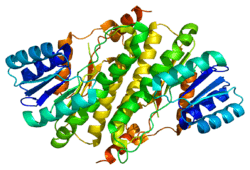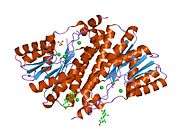HSD17B11
| View/Edit Human | View/Edit Mouse |
Estradiol 17-beta-dehydrogenase 11 is an enzyme that in humans is encoded by the HSD17B11 gene.[3][4][5][6]
References
- ↑ "Human PubMed Reference:".
- ↑ "Mouse PubMed Reference:".
- ↑ Brereton P, Suzuki T, Sasano H, Li K, Duarte C, Obeyesekere V, Haeseleer F, Palczewski K, Smith I, Komesaroff P, Krozowski Z (Feb 2001). "Pan1b (17betaHSD11)-enzymatic activity and distribution in the lung". Mol Cell Endocrinol. 171 (1-2): 111–7. doi:10.1016/S0303-7207(00)00417-2. PMID 11165019.
- ↑ Chai Z, Brereton P, Suzuki T, Sasano H, Obeyesekere V, Escher G, Saffery R, Fuller P, Enriquez C, Krozowski Z (Apr 2003). "17 beta-hydroxysteroid dehydrogenase type XI localizes to human steroidogenic cells". Endocrinology. 144 (5): 2084–91. doi:10.1210/en.2002-221030. PMID 12697717.
- ↑ Persson B, Kallberg Y, Bray JE, Bruford E, Dellaporta SL, Favia AD, Duarte RG, Jornvall H, Kavanagh KL, Kedishvili N, Kisiela M, Maser E, Mindnich R, Orchard S, Penning TM, Thornton JM, Adamski J, Oppermann U (Feb 2009). "The SDR (short-chain dehydrogenase/reductase and related enzymes) nomenclature initiative". Chem Biol Interact. 178 (1-3): 94–8. doi:10.1016/j.cbi.2008.10.040. PMC 2896744
 . PMID 19027726.
. PMID 19027726. - ↑ "Entrez Gene: HSD17B11 hydroxysteroid (17-beta) dehydrogenase 11".
Further reading
- Li KX, Smith RE, Krozowski ZS (1999). "Cloning and expression of a novel tissue specific 17beta-hydroxysteroid dehydrogenase.". Endocr. Res. 24 (3-4): 663–7. doi:10.3109/07435809809032667. PMID 9888557.
- Haeseleer F, Palczewski K (2000). "Short-chain dehydrogenases/reductases in retina.". Meth. Enzymol. 316: 372–83. doi:10.1016/S0076-6879(00)16736-9. PMID 10800688.
- Strausberg RL, Feingold EA, Grouse LH, et al. (2003). "Generation and initial analysis of more than 15,000 full-length human and mouse cDNA sequences.". Proc. Natl. Acad. Sci. U.S.A. 99 (26): 16899–903. doi:10.1073/pnas.242603899. PMC 139241
 . PMID 12477932.
. PMID 12477932. - Clark HF, Gurney AL, Abaya E, et al. (2003). "The secreted protein discovery initiative (SPDI), a large-scale effort to identify novel human secreted and transmembrane proteins: a bioinformatics assessment.". Genome Res. 13 (10): 2265–70. doi:10.1101/gr.1293003. PMC 403697
 . PMID 12975309.
. PMID 12975309. - Hartmann TB, Thiel D, Dummer R, et al. (2004). "SEREX identification of new tumour-associated antigens in cutaneous T-cell lymphoma.". Br. J. Dermatol. 150 (2): 252–8. doi:10.1111/j.1365-2133.2004.05651.x. PMID 14996095.
- Gerhard DS, Wagner L, Feingold EA, et al. (2004). "The status, quality, and expansion of the NIH full-length cDNA project: the Mammalian Gene Collection (MGC).". Genome Res. 14 (10B): 2121–7. doi:10.1101/gr.2596504. PMC 528928
 . PMID 15489334.
. PMID 15489334. - Otsuki T, Ota T, Nishikawa T, et al. (2007). "Signal sequence and keyword trap in silico for selection of full-length human cDNAs encoding secretion or membrane proteins from oligo-capped cDNA libraries.". DNA Res. 12 (2): 117–26. doi:10.1093/dnares/12.2.117. PMID 16303743.
- Kimura K, Wakamatsu A, Suzuki Y, et al. (2006). "Diversification of transcriptional modulation: large-scale identification and characterization of putative alternative promoters of human genes.". Genome Res. 16 (1): 55–65. doi:10.1101/gr.4039406. PMC 1356129
 . PMID 16344560.
. PMID 16344560.
This article is issued from Wikipedia - version of the 5/31/2016. The text is available under the Creative Commons Attribution/Share Alike but additional terms may apply for the media files.


